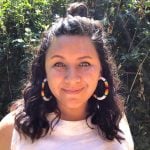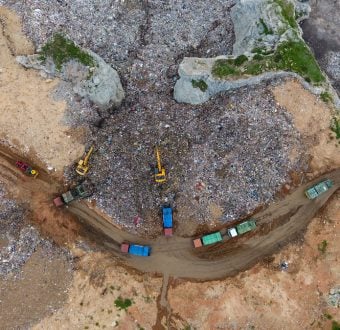Black, brown, and Indigenous Peoples bear the brunt of pollution from mining, farming, factories, and power plants. Our communities are also the first ones to suffer the worst effects of fossil-fueled climate change: displacement from rising seas, mega-droughts, deadly heatwaves, and strengthening storms.
Unsurprisingly, Black, brown, and Indigenous Peoples are on the frontlines of the fight against the extractive industries at the heart of the environmental crisis.
Yet, the historically white-led, mainstream environmental movement has failed and excluded Black, brown, and Indigenous peoples for decades. Greenpeace is no exception.
This is a truth that many Black, brown, and Indigenous staff at Greenpeace struggle with every day — how to reconcile this legacy and push Greenpeace to be better. To do that we must acknowledge Greenpeace’s history, how it has harmed or excluded Indigenous communities, and where healing is needed.
Honoring the Sacred
At times Greenpeace offices around the world have failed to honor what is sacred to Indigenous Peoples, either through cultural appropriation or recklessness. These moments have given us important lessons on reconciliation.
On Greenpeace’s founding voyage to stop nuclear testing off the coast of Alaska the Greenpeace crew visited members of various Kwakwaka’wakw nations on two occasions. On one, they were acknowledged by members of the ‘Namgis and other Kwakwaka’wakw nations for their courage in standing up to the United States military-industrial complex with a special ceremony that included song, dance, and food. The crew had Kwakwaka’wakw traditional regalia placed on them, with eagle down on their heads, and they even participated in one of the ceremonial dances – the Peace Dance (or Tla’sala, in the Kwak’wala language). This was a huge honor. At one point, a leading member of a Kwakwaka’wakw nation gave the crew a blue cloth featuring a Sisiutl, a powerful spiritual crest amongst various coastal First Nations of British Columbia. The Sisiutl itself is a supernatural creature with two serpent heads, representing the balance of good and evil. Only certain Kwakwaka’wakw individuals and families (as well as other coastal First Nations) have the cultural and spiritual rights to display the Sisiutl in ceremonies, so to have the Sisiutl shared with Greenpeace was another huge honor.
Unfortunately, Greenpeace would go on to appropriate and modify this symbol for ships, offices, and t-shirts around the world. This was a grave dishonor and led to frayed relationships with First Nation communities.
Over the last decade, staff at Greenpeace Canada began the work to repair relationships with First Nations on the West Coast of Turtle Island, and have given us an example of what some part of the long path of healing and reconciliation can look like. Our Canadian colleagues sat with the community, agreed Greenpeace would never use the modified Sisiutl again, and worked with famed Indigenous artist, Beau Dick, and members of Kwakwaka’wakw nations, to develop the Sisiutl pictured below that Greenpeace could use and still honor it.

As with the Rainbow, the Sitsiutl symbol has been part of the Greenpeace visual identity since Greenpeace’s first voyage when the original symbol was gifted to the crew to encourage them to continue their journey. As a testament to the importance of this gift, it was taken and over the decades “adapted” from the original form. In 2015 renowned Kwakwaka’wakw artist Beau Dick graciously agreed to re-create the traditional Sisiutl symbol, to be shared and re-gifted to Greenpeace with the shared understanding that its design would always remain true.
More recently, in 2014, some of our international colleagues laid a message at the sacred Nazca Lines in Peru. Greenpeace offices around the world apologized without reservation and while the message had no malign intent, the organization acknowledges there is no apology sufficient for what was done and the serious lack of judgment that let it happen.
At Greenpeace USA, the incident spurred the long-overdue adoption of our Indigenous Peoples Policy. The policy is meant to demonstrate both organizational respect for Indigenous communities and an intention to improve the way our organization interacts and works with them.
The policy states agreements such as that the staff and board of Greenpeace USA support Indigenous efforts for autonomy and self-determination, recognize customary legal systems and traditions of Indigenous Nations, and will conduct its campaigns in a manner that respects and reinforces their authority and autonomy. It also recognizes the right of Indigenous Peoples to carry out traditional activities, such as sustainable fishing, hunting, trapping, whaling, gathering first foods and medicine, on their traditional territories and waters.
Policy and intention are just that, and Greenpeace has much more work to do for healing.
From Wildlife Campaigns to Indigenous Solidarity
To begin reorienting our work, Greenpeace USA acknowledges that its campaigns have caused great harm against Indigenous communities.
Specifically, the organization’s work in the late 70s and early 80s to protect populations of whales and seals did not do enough to take the lead of Indigenous hunters and differentiate between the commercial over-hunting Greenpeace was campaigning against and the traditional subsistence hunting that is central to various Indigenous Peoples’ cultures, incomes, and livelihoods, for long before colonization and its resulting capitalistic practices.
For that, we apologize.
Greenpeace Canada’s former Executive Director’s apology to Inuit for the impact of the seal campaign is an important statement on this history. She wrote, “Though the campaign was directed against the commercial hunting of seals — and not the small-scale, subsistence hunting carried out by Northern Indigenous and coastal peoples — we did not always communicate this clearly enough. The consequences of that, though unintended, were far-reaching.” Many countries would outright ban seal products, devastating Indigenous sealing communities. The impacts did not differentiate between commercial over-hunting and the relationship that Indigenous peoples have with the animals they hunt for food, clothing, income, and cultural purposes. They take only what they need, and no more. They honor the animals, the land, and the ocean. This special relationship has existed since time immemorial, and Greenpeace respects and honors this Indigenous knowledge, rights to sovereignty, and those relationships.
Today, we wish to move beyond apologies, to strive for healing within communities. A key piece of this is centering Indigenous rights within our campaigns.
Centering Indigenous Peoples isn’t only just; it’s vital to winning a green and peaceful future. A new report from the Indigenous Environmental Network and Oil Change International makes clear that Indigenous resistance could stop up to nearly one-quarter of US and Canadian carbon emissions.
Indigenous Peoples comprise 5% of the world’s population, yet their lands encompass 22% of its surface and are home to 80% of the planet’s biodiversity. Increasing and affirming Indigenous sovereignty and land stewardship will protect these places, ecosystems, and wildlife.
The global Greenpeace network is increasingly working with Indigenous communities around the world, from the Amazon to the frontlines in the US, but we know this is only the very beginning of a healing journey with the communities the organization has harmed.
Indigenous Leadership
Greenpeace USA is committed to challenging the systems of power and privilege that destroy the environment and place disproportionate burdens on vulnerable communities. But the organization can’t effectively, or justly, do that unless our board, management, staff, and activist network are made up of Black, brown, Indigenous, and working-class people.
But like other Big Green environmental organizations in the US, Greenpeace was founded by and led by white people up until just recently. This dynamic is starting to change. Greenpeace USA has also embraced a multiracial co-leadership model at both our board and executive levels with the appointment of Jakada Imani as our first Black board chair and with Ebony Twilley Martin as the first Black Co-Executive Director. Thanks to an enormous effort led by Ebony, Greenpeace USA’s staff is 45% Black, Indigenous, and staff of color — up from 13% from 2014. Welcome progress, but not enough. And the fact remains that the number of Indigenous Peoples on staff is still very small — and today can be counted on one hand.
To rectify this, we must first increase the recognition of our work’s intrinsic connection to Indigenous rights. Not the other way around.
Some of that recognition must be achieved in the way we work. For example, this is the first year that Indigenous Peoples Day will be recognized as a holiday at Greenpeace USA — a milestone that emerged from the ongoing collective bargaining process between the Greenpeace Workers Union and management.
But that recognition must also happen through what campaigns we work on and the allies we uplift. Everything we do touches on Indigenous issues because it’s all done on stolen land and the fossil-fueled climate crisis that we are fighting affects Black, brown, and Indigenous Peoples first and foremost.
How Greenpeace USA utilizes its resources and shows up for Indigenous allies is a growing edge. But we’re hopeful that this chapter of our organizational story will bring more Indigenous Peoples into our organization as leaders and put more of the climate movement’s weight behind the call for Indigenous sovereignty and Land Back — restoring stolen lands to Indigenous Peoples, a move that will truly upend the power of greedy polluters and ensure climate justice for all.
This is a pivotal moment in the fight for climate action — and the only way we will achieve that green and peaceful future is by listening to and centering Indigenous Peoples in our work.
—
This essay is part of our Perspectives: Our Next Fifty Years series, in which we reflect briefly on our first fifty years, but more importantly, we lay out the future we are building together—collaborative, ambitious, and intersectional. The work ahead won’t be easy, but we’ve never shied away from hard work. We continue to push for policies that recognize the contributions and leadership of marginalized groups, and we amplify their voices, looking to their wisdom to show us the way. We hold corporations accountable, demanding real action that puts people ahead of profit. We work each day with our partners to co-create green, safe planet for all beings. We recognize that equality is not necessarily justice. We demand more from our leaders, from our colleagues, and from ourselves. A green and peaceful world isn’t just a slogan—it is our mission, and it takes each one of us to get there.



